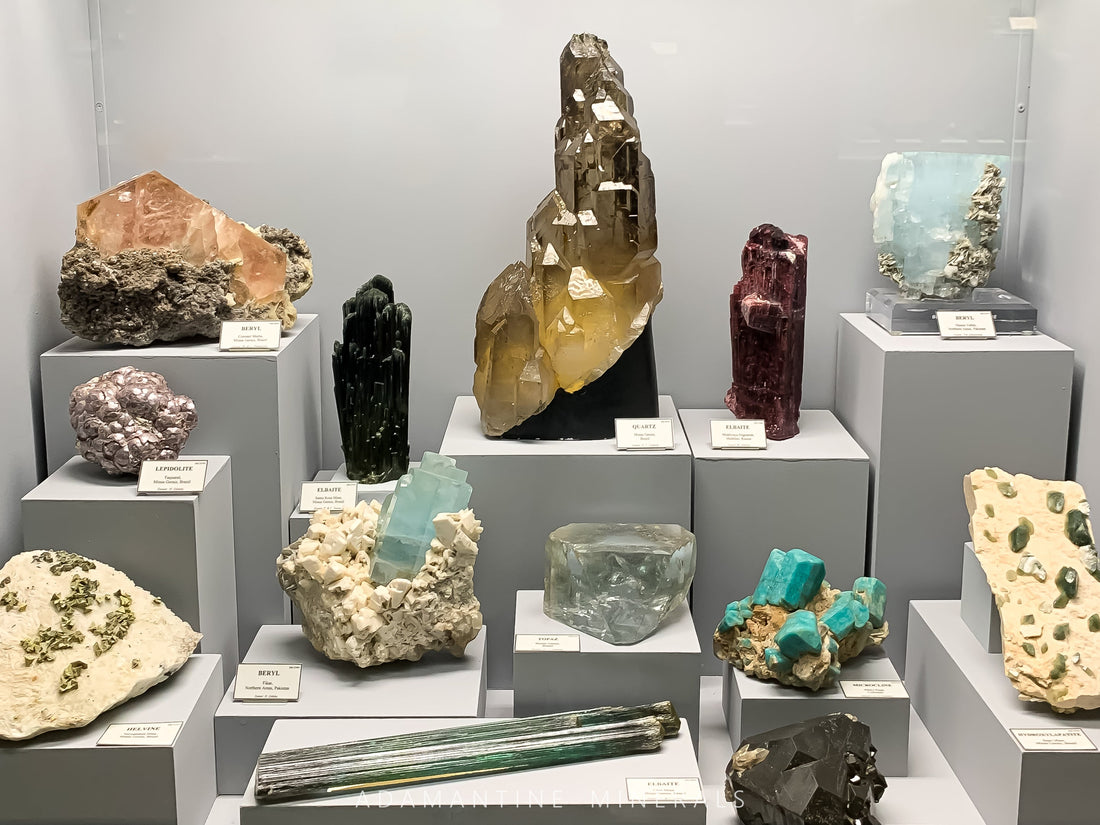
Mineral Displays: A Setup Guide
A thoughtfully arranged mineral display can transform your collection from a storage shelf into a captivating showcase—like your own little museum of Earth’s natural wonders.
Whether you’ve accumulated hundreds of mineral specimens over the years or are just beginning to take an interest in mineral collecting, setting up a display can seem daunting. This guide will walk you step by step through planning and putting together a display that beautifully showcases your prized specimens.
1. Choose Your Focus
Before gathering shelves and stands, decide on the purpose of your display.
Mineral museums are often designed to showcase specimens in a way that is both educational and engaging, so they can serve as a great source of inspiration. Find the aspect of minerals that intrigues you most and build your display around that. Some areas of interest to consider highlighting:
Formation: Group minerals based on the geological formations from which they came. This allows you to showcase the various petrogenetic environments. Consider groupings like pegmatite specimens, evaporite minerals, or pseudomorphs to illustrate the processes that yielded these natural treasures.
Art: Focus on visual interest by arranging specimens to highlight their sculptural forms and diverse appearances. Placing contrasting colors and distinctly different habits next to each other creates an artful and dynamic display.
Locality: Organize specimens by their locality to emphasize minerals from different parts of the world. This works especially well for collections from many localities or for self-collected specimens.
Mineral type: Displaying minerals of the same species or mineral group is a great way to demonstrate its diversity. A display of calcites, as shown below, shows the variety that can be seen in a single mineral species. 
2. Select Your Display Furniture
Select display units that suit your space and style. Also consider features such as built-in lighting, adjustable shelving, or UV-filtered glass to protect light-sensitive minerals like fluorite or amethyst.
Display Cabinets: Standing cabinets, such as curio or china cabinets, are perfect for showing off minerals. Shopping secondhand can be a cost-effective way to find a great case.
Shadow Boxes or Shelf Displays: Ideal for smaller collections or themed displays.
Most importantly:
Ensure your shelves can support the weight of your specimens. Check the weight capacity of each shelf, especially if you're using glass, which may not be suitable for heavier specimens. Distribute weight evenly and avoid overloading shelves without knowing their weight limits.
3. Selecting Bases
Placing each specimen on a dedicated base not only gives your display a cleaner, more organized look, but it also allows you to present the mineral at the best angle for viewing. Consistency throughout your display enhances its visual appeal and keeps the focus on the minerals themselves. You can use mineral putty or custom bases for this.

The right platform enhances each specimen:
Materials: Clear acrylic bases are great because they let light reach the specimen, showcasing its clarity and details. Wood or opaque bases can offer a more vintage or natural feel.
Size: Ensure the base's footprint doesn't extend beyond the edges of the specimen to maintain an elegant look. Using uniform base sizes for specimens of similar size creates a cohesive appearance. Be mindful of the base's thickness when making purchases!
4. Arrangement
The arrangement of your specimens is key to creating an appealing and organized display. The way you position your minerals relative to each other not only enhances their visibility but also optimizes your use of space. Here are some strategies to improve placement:
Tiered Steps or Risers: Use risers to create multiple levels on your shelves, ensuring each specimen is visible. If you have shorter risers, stagger specimens to create visual gaps, letting minerals be seen from different angles.

Sizing: For a balanced display, separate larger and smaller specimens. If you’re using tiers, place smaller specimens on the upper tiers and larger ones on the lower tiers. This will add visual harmony and prevent the top shelves from appearing overcrowded. If you’re not using tiers, place larger specimens behind smaller ones to avoid blocking them.
Color and Shape: When arranging specimens, consider both their color and shape to create a dynamic display.
Contrast: Position specimens with contrasting colors next to each other to ensure each mineral stands out. Alternate between single crystals and clusters to provide variety in form and texture.
Grouping by Color: If your collection focuses on one or a few colors, grouping similar hues together creates a striking visual impact. Just remember to balance this with the shape and size of the specimens to avoid a monotonous look.
By thoughtfully considering placement, sizing, and the interplay of colors and shapes, you can create an arrangement that highlights the beauty of your collection while keeping the display visually engaging.
5. Labeling Your Minerals
Clear and consistent labeling adds both educational value and professionalism to your display. While mineral type and locality are always recommended on labels, there is a lot more that you can include. When determining the format, consider what information you find most interesting about each specimen.
Label Format: Most people include the mineral type and locality on the label. Depending on your focus, you might also want to include the year of collection, chemical formula, ex-collection info, crystal class, or even your name if it's a personal collection.
Materials: Printed cards work well for creating multiple labels, especially if you want to include a lot of information. Engraved acrylic bases provide a sleek, professional look but may be pricier. Alternatively, use a label maker to print white or black text on clear labels to stick on the bases themselves, as shown on the bases in the photo above.
Maintain a consistent font style and size across all labels to ensure cohesiveness.
6. Lighting Considerations
Proper lighting can make all the difference in your display. When choosing lighting, pay attention to the tint of the light and how it will affect the colors of your specimens. Some lighting setups may become warm, so be cautious of placing lights too close to temperature-sensitive minerals. Sudden temperature changes can cause fractures in crystals, so it's important to avoid placing specimens near hot lights.
You’ll likely want to tweak your display over time. Adding new specimens, rotating pieces, or experimenting with new groupings is part of the fun. Feel free to play around with different layouts, backdrops, and lighting until you find the perfect arrangement.
